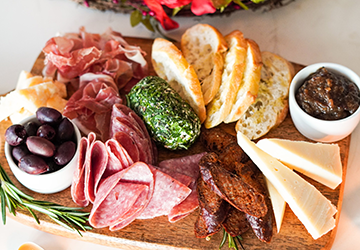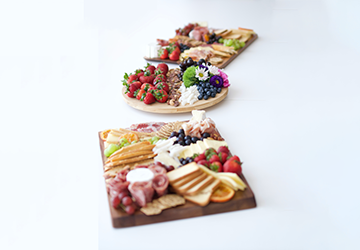Creating the ultimate charcuterie board is an art and an excellent way to impress your guests at any party. A well-crafted charcuterie board is a fantastic conversation starter and offers a tasty variety of flavors and textures. This guide will delve into crafting a compelling and visually impressive charcuterie board for your upcoming get-together.
So, let's jump in and uncover the hidden techniques for creating an excellent party starter!
Choosing Your Board
The foundation of your charcuterie masterpiece is the board itself. Select a board large enough to hold all your ingredients without overcrowding. Wooden panels, marble slabs, or large cutting boards can work well. Ensure that the material is food-safe and easy to clean.
Selecting the Perfect Meats
The star of any charcuterie board is, of course, the meats. Here are some categories of hearts to consider:
l Cured Meats
Cured meats like prosciutto, salami, and coppa are charcuterie staples. Opt for diverse textures and tastes to maintain your guests' curiosity and delight.
l Pâtés and Terrines
Rich, flavorful pâtés and terrines made from liver, meat, or seafood add depth to your board.
l Smoked Meats
Smoked meats, such as smoked salmon or duck breast, bring a unique, smoky flavor.

The Art of Cheese Pairing
Cheese is another essential component of a charcuterie board. Consider these categories when selecting cheeses:
l Aged Cheeses
Aged cheeses, such as cheddar, Gruyère, or Manchego, offer a firm texture and complex flavor.
l Soft Cheeses
Soft cheeses, like Brie, Camembert, or goat cheese, provide a creamy, mild contrast to the bold flavors of the meats.
l Blue Cheeses
For those who appreciate a bit of funk, blue cheeses like Gorgonzola, Roquefort, or Stilton are perfect additions.
Crunchy Accompaniments
Adding a bit of crunch to your board is essential. Here's what to consider:
l Crackers and Bread
Choose a variety of crackers, sliced baguettes, or rustic bread to provide a canvas for your meats and cheeses.
l Nuts
Nuts like almonds, walnuts, or pistachios add a delightful crunch and pair well with meats and cheeses.
Sweet and Savory Spreads
Spreads like fig jam, honey, or whole-grain mustard provide a sweet or savory counterpoint to the richness of the meats and cheeses. Explore various tastes and consistencies to discover the ideal combinations that complement each other.
Fresh and Dried Fruits
Add fresh and dried fruits to your charcuterie board for natural sweetness and color. Grapes, sliced apples, and berries are new options, while dried apricots, figs, or dates add a concentrated, chewy sweetness.
Pickled and Marinated Goodies
Pickled vegetables and marinated olives bring a tangy, salty flavor that balances the richness of the meats and cheeses. Consider including classics like cornichons or marinated artichoke hearts and unique options like pickled asparagus or marinated mushrooms.
Garnishes and Extras
Garnishes add a finishing touch to your charcuterie board. Fresh herbs like rosemary or thyme look beautiful and add a pleasant aroma. Bittersweet chocolate or consumable blossoms serve as choices for adding a vibrant touch of hue and taste.
Wine and Beverage Pairings
Pairing your charcuterie board with the right wine or beverage elevates the experience. Sparkling wines like Champagne or Prosecco complement the salty and fatty flavors of the meats and cheeses. Alternatively, a light, crisp beer or a refreshing cocktail works well with various charcuterie elements.
Arranging Your Charcuterie Board
When arranging your board, start by placing the meats and cheeses, then fill in the gaps with accompaniments like spreads, fruits, and nuts. This allows for a visually appealing and easy-to-navigate presentation.

Serving Tips and Tricks
Ensure all your meats and cheeses are at room temperature before serving to bring out their full flavors. Provide small forks or toothpicks for guests when sampling the various items on your board.
Presentation and Aesthetics
Elevate your charcuterie board by emphasizing its visual appeal. Incorporate a diverse mix of hues, textures, and elevations to fashion a captivating presentation. Embrace your creativity when designing the arrangement, and remember that a bountiful, generously filled board is perpetually enticing.
Conclusion
Crafting the ultimate charcuterie board for entertaining requires attention to detail, a diverse selection of high-quality ingredients, and a focus on presentation. Following these tips and considering your guests' tastes and preferences will create a memorable and mouthwatering appetizer that everyone will enjoy.
FAQs
1. What is charcuterie?
Charcuterie is the art of preparing and assembling cured meats, cheeses, and other accompaniments, traditionally served on a wooden board or platter.
2. How much meat and cheese should I serve per person?
A general rule of thumb is to offer 2-3 ounces of meat and cheese for each guest, modifying the amount depending on their hunger and other meal options.
3. Can I make a vegetarian or vegan charcuterie board?
Absolutely! Substitute the meats with plant-based alternatives like marinated tempeh, vegan cheeses, and various vegetables, fruits, and spreads.
4. How far in advance can I prepare my charcuterie board?
It's best to assemble your charcuterie board within a few hours of serving to ensure the freshness and quality of the ingredients. However, you can prepare the individual components ahead of time, storing them separately in the refrigerator.
5. How do I store leftover charcuterie items?
Wrap leftover meats and cheeses in parchment paper or plastic wrap and store them in the refrigerator. Most items will keep for several days, but always check for freshness before consuming.




